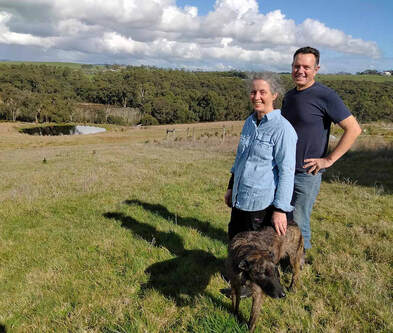 Emma and Steve Plowright have no intention of pretending to be farmers.
Emma and Steve Plowright have no intention of pretending to be farmers. WHEN friends and strangers ask Emma and Steve Plowright what they plan to do with their Woodleigh farm, they are often taken aback by the answers.
“As little as possible,” Emma jokes.
“Are you going to graze cattle?”
“No,” says Steve. “We’re trying to create habitat.”
“So you’re going to harvest the timber?”
“No. Why would we put the bush back and then cut it down?”
“We’re not pretending to be farmers,” says Emma. “If we had stock we would have to fence the areas of new planting. It’s not worth the investment in fencing to have a few cows.
“There’s so much land clearing, the natural environment needs some help. We’re very happy for the native animals to have it all. We just prefer they have a free run and a place to live.”
Emma has always loved the bush. Like many people, she’s observed the continuing clearing of land in the name of progress. With a bequest from her grandmother – a lover of nature – she decided to buy a patch of bush and preserve it.
In late 2020, as Victoria was emerging from the first round of Covid, she finally saw what she wanted. A 50-hectare farm at Woodleigh. “Escape to your own country dream!” was the tagline.
Amidst the real estate blurb, a sentence caught her eye: “Along the way you can witness the local kangaroos, wallabies, an occasional wombat and a large variety of native bird life.” Over half the property was bush – not so great for farming purposes but perfect for her purposes.
“We came for a walk with the real estate agent. I saw this patch of old messmates. This is what sold the property for us. I knew I wanted to protect them.
“Steve’s a builder/carpenter and he could see it. He went from 0 per cent interested in having a property to 100 per cent in an hour.”
They’d brought a couple of friends with them on that first visit. “Mark grew up on a farm and he’s checking the grass,” Steve says. “He’s asking ‘What are you going to use it for?’ Then he walked into the bush and he understood. Now they love coming down here to help with the weeding.”
When Emma and Steve returned a couple of weeks later for a proper walk, they discovered more and more diversity, from sand ridges covered in grass trees to deep shady gullies filled with tree ferns and orchids. Everywhere there were birds and evidence of wombats and roos.
“It was just magical,” Emma said.
Their patch of bush is a crucial piece of the jigsaw that makes up the Western Port Woodlands, the forest corridor of conservation reserves and remnant vegetation on private land running roughly parallel to the bay between Lang Lang and Bass.
This is the last significant remnant forest in the Gippsland Plains bioregion, and crucial for the survival of locally threatened species including southern brown bandicoots, swifts parrots, lace monitors and powerful owls.
It’s also under threat from a surge in sand mining. On the northern side of their property, the former Holden Proving Ground, almost 900 hectares of remnant vegetation, is currently on the market with half designated Extractive Industry Interest Area. The large property to the west is owned by mining giant Boral, which has an active work application for sand extraction on mature bushland. To the south and east, as far as the eye can see is cleared farmland.
All of which makes Emma and Steve’s patch of bush an extremely valuable biolink for threatened species. News of their intent spread rapidly. There aren’t too many landowners willing to put biodiversity at the top of their list.
First to approach them was the Bass Coast Landcare Network, which did some planting last year. This month Greening Australia will plough and direct seed about six and a half acres of pasture in a seeding experiment.
Melbourne Water has sprayed along the creek and around the dams and a team of 70 staff from Astra Zeneca will plant seedlings as a corporate bonding exercise. Landcare will finish off the planting. Emma says it’s great to see the three groups working together.
They are working with Trust for Nature to put a covenant on the back half of the block to preserve it for posterity. The covenant comes with a list of obligations. They have to keep the boundary fence intact and manage the weeds but mostly it’s a list of things they’re not allowed to do. They’re not allowed to maintain tracks, except on the boundary. They’re not allowed to pick up fallen timber. They’re not allowed to collect firewood.
Emma says it’s almost as if they’ve been given permission just to enjoy the place. Every walk brings new discoveries … a patch of greenhood orchids here, a family of boobook owls living in the barn, the call of a whip bird there, a helmet orchid.
“It’s really rather liberating. Rather than walking around thinking ‘OMG, another tree’s fallen over’, you just walk on. The more leaf litter and fallen trees the better.”